| Pages:
1
..
14
15
16
17
18
..
40 |
hkparker
National Hazard
   
Posts: 601
Registered: 15-10-2010
Location: California, United States
Member Is Offline
Mood: No Mood
|
|
Quote: Originally posted by barley81  | Iodine ingot made by melting iodine under concentrated sulfuric acid. Credit goes to woelen for suggesting this.
|
Oh cool, I'll have to try this.
Here's some Tris(acetylacetonato)iron(III) I made in chem lab:
Not a great photo but its pretty cool in person.
<a target="tab" href="http://sciencemadness.org/scipics/IMG_20120425_183748.jpg"><img height="237" width="372"
src="http://sciencemadness.org/scipics/IMG_20120425_183748.jpg"></a>
[Edited on 26-4-2012 by hkparker]
My YouTube Channel
"Nothing is too wonderful to be true if it be consistent with the laws of nature." -Michael Faraday
|
|
|
barley81
Hazard to Others
  
Posts: 481
Registered: 9-5-2011
Member Is Offline
Mood: No Mood
|
|
What a beautiful compound! I wonder where you can get acetylacetone, and if other transition metals will make such lovely crystalline complexes.
|
|
|
hkparker
National Hazard
   
Posts: 601
Registered: 15-10-2010
Location: California, United States
Member Is Offline
Mood: No Mood
|
|
In lab other groups did cobalt, copper, and chromium. They all looked pretty cool, but iron was probably the prettiest due to its reflective
properties. Copper was a pale blue but I remember it being a dull powder. Chromium was green but very dark, cobalt was very dark.
I haven't looked for acetylacetone but I'm sure its around.
My YouTube Channel
"Nothing is too wonderful to be true if it be consistent with the laws of nature." -Michael Faraday
|
|
|
Teen Chemist
Harmless

Posts: 42
Registered: 27-4-2012
Member Is Offline
Mood: Effervescent
|
|
Some crude triethyl borate a relative of trimethyl borate the camera doesnt do the green flame justice.
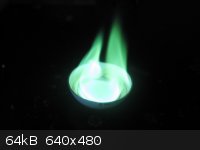
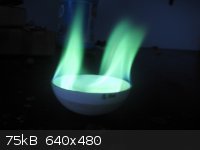
|
|
|
White Yeti
National Hazard
   
Posts: 816
Registered: 20-7-2011
Location: Asperger's spectrum
Member Is Offline
Mood: delocalized
|
|
Since everyone seems to like green, I'll make a humble contribution along these lines. The emission spectrum of copper:
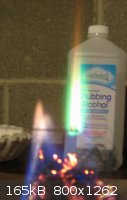
Copper acetate inserted into the flame of my home made isopropyl burner. The picture's a little fuzzy because of the low light conditions.
"Ja, Kalzium, das ist alles!" -Otto Loewi
|
|
|
Dennis SK
Harmless

Posts: 21
Registered: 12-3-2012
Member Is Offline
Mood: No Mood
|
|
Nice flametests!
I have a picture of a cesium flametest I made a few years ago. Will find it and post it soon (its on another computer)
Cesium can with some effort produce a beautiful and quite unique light-blue or "Skyblue" flame 
|
|
|
Endimion17
International Hazard
    
Posts: 1468
Registered: 17-7-2011
Location: shores of a solar sea
Member Is Offline
Mood: speeding through time at the rate of 1 second per second
|
|
Guys, it seems to me almost none of you really put any effort in making a nice photograph. Those are just snapshots.
I understand, those flames/chemicals are very pretty, but the photos aren't. I don't see their beauty captured in an image. The thread is about pretty
pictures, and the theme are experiments, compounds, etc.
Please don't say your camera is bad. That's not an excuse. People do amazing things with shitty cameras all the time, and I'm not talking about the
Instagram crap.
Come on, put some effort in it. 
|
|
|
kristofvagyok
National Hazard
   
Posts: 659
Registered: 6-4-2012
Location: Europe
Member Is Offline
Mood: No Mood
|
|
You meant something like this?
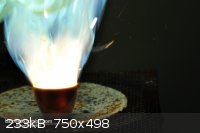
I have a blog where I post my pictures from my work: http://labphoto.tumblr.com/
-Pictures from chemistry, check it out(:
"You can’t become a chemist and expect to live forever." |
|
|
Endimion17
International Hazard
    
Posts: 1468
Registered: 17-7-2011
Location: shores of a solar sea
Member Is Offline
Mood: speeding through time at the rate of 1 second per second
|
|
Exactly. 
My complaint wasn't pointed to your work, which is really great, as I've mentioned earlier. Some photos you've taken could be used for making fancy
chemistry textbooks.
|
|
|
White Yeti
National Hazard
   
Posts: 816
Registered: 20-7-2011
Location: Asperger's spectrum
Member Is Offline
Mood: delocalized
|
|
Granted, I'm not a talented photographer, and I'm not going to put a blame on my camera. However, there are some phenomena that are just difficult to
capture. I challenge you to take a picture of the flame test of an element. You have to remember that a flame test is a fleeting moment in time and
that the flame you choose to use is in constant motion. Although you can choose to use a higher shutter speed and get something like what kristof got,
you can also choose a regular shutter speed and risk getting a fuzzy picture (which is what I got). The problem with a short exposure is that you
upset the balance between the brightness of whatever phenomenon you choose to take a picture of, and its background.
I'll try again and see if I can take a better picture of a flame test of copper.
[edit]
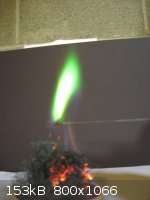
I'm not sure if it's better or worse, I'll leave it up to you to decide. I tried to use macro, but it doesn't work with a moving target.
[Edited on 4-30-2012 by White Yeti]
"Ja, Kalzium, das ist alles!" -Otto Loewi
|
|
|
Endimion17
International Hazard
    
Posts: 1468
Registered: 17-7-2011
Location: shores of a solar sea
Member Is Offline
Mood: speeding through time at the rate of 1 second per second
|
|
I'm well aware of the technical difficulties, however, that wasn't my point. What I meant was to work on the details. For example, why are we seeing
parts of your ceramic wall tiles? Get it now? 
Photography is an art, too. If you want to focus the viewer onto a chemical reaction, don't distract him with things like tiles and dirt spots (that's
what photo editing software is for).
As for the capturing of the dynamics of the flame, copper gives a very luminous blue-green flame. I'm sure it could be caught with a digital camera in
all its glory if you use 1/800 s and ISO-200 or 400.
Yes, digital macro shooting can be a pain in the ass. That's why there's something called focus locking. You put your finger where you expect the
flame to be, press the first step of the button, and then while holding it, start the flame and then press the whole way down. Timer can help.
Dimming lights helps a lot. And if you want some equipment to be visible, you can always take two photos without moving the camera, and then merging
them in a software. One lit normally, one with the flame.
Here's an example of a flame less luminous than copper flame.
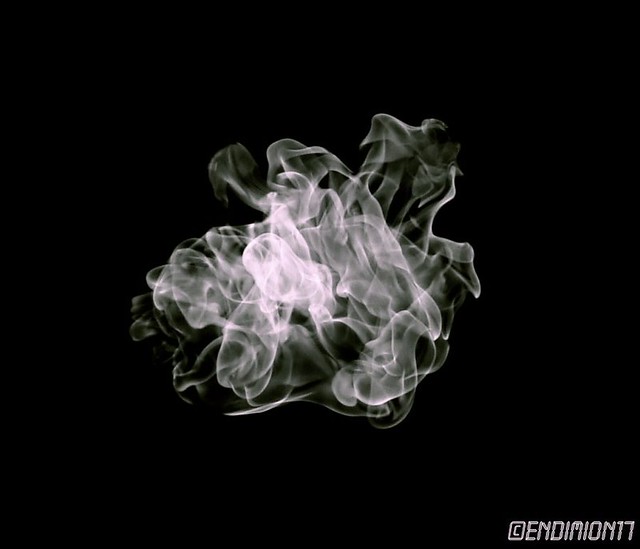
It was probably 1 ml of acetone sprinkled towards the camera in dark conditions. I think the shutter speed was 1/800 s.
It's one of many similar photos. Here's butane flame deflagration, edited for lulz.
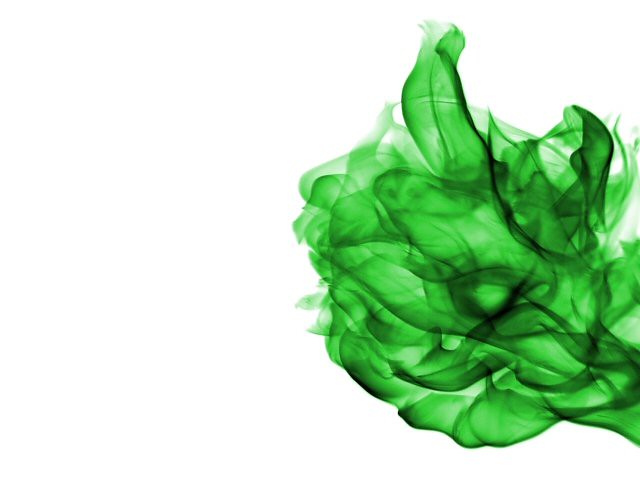
Use your imagination. 
|
|
|
cyanureeves
National Hazard
   
Posts: 744
Registered: 29-8-2010
Location: Mars
Member Is Offline
Mood: No Mood
|
|
damn! dude that is like time-life quality, heck even an old donkey will come out as a pretty picture.nice pic and good thing it's about chemistry not
an old mule.
[Edited on 1-5-2012 by cyanureeves]
[Edited on 1-5-2012 by cyanureeves]
|
|
|
Arthur Dent
National Hazard
   
Posts: 553
Registered: 22-10-2010
Member Is Offline
Mood: entropic
|
|
Our friend Woelen has a nice little primer on his website entitled "Guidelines for successful chemistry-related photography"... very interesting and
simple techniques for photography using proper lighting of the subject and the background.
Robert
--- Art is making something out of nothing and selling it. - Frank Zappa ---
|
|
|
sargent1015
Hazard to Others
  
Posts: 315
Registered: 30-4-2012
Location: WI
Member Is Offline
Mood: Relaxed
|
|
BaCl2
Fresh barium chloride crystals! Just made them last night and they are slowly crystallizing out 
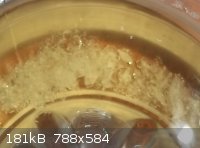
Copper II acetate crystals with what appears to be copper carbonate residue on them. Anyone have a solution to get rid of that? More acetic acid? The
crystals are gorgeous, minus that small flaw
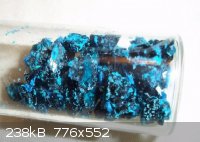
btw, sorry about the poor picture quality, trying to get within the post-able limits is tougher than I expected!
|
|
|
MrHomeScientist
International Hazard
    
Posts: 1806
Registered: 24-10-2010
Location: Flerovium
Member Is Offline
Mood: No Mood
|
|
Quote: Originally posted by sargent1015  | | Copper II acetate crystals with what appears to be copper carbonate residue on them. Anyone have a solution to get rid of that? More acetic acid? The
crystals are gorgeous, minus that small flaw |
If it is indeed copper carbonate, I should think a dip in some acid would be get rid of it easily. The bubbles produced should help knock the pieces
off your crystals, too. Try shaking a crystal around a bit in acetic acid and see if that helps. If not, go a step higher and try hydrochloric - that
should dissolve the carbonate more quickly and shouldn't (I think) mess with your acetate crystals any. Of course, they will shrink slightly as they
dissolve in whatever solution you dip them in.
|
|
|
sargent1015
Hazard to Others
  
Posts: 315
Registered: 30-4-2012
Location: WI
Member Is Offline
Mood: Relaxed
|
|
Crystals
Thanks! I will try that out and post pictures of the results. If all else fails, I'll boil them down and make a new batch.
Crystal growing is exciting even if you have to destroy some to make more 
|
|
|
Endimion17
International Hazard
    
Posts: 1468
Registered: 17-7-2011
Location: shores of a solar sea
Member Is Offline
Mood: speeding through time at the rate of 1 second per second
|
|
For god sake, hydrochloric acid is going to ruin them. Stronger acid pushes the weaker one's anion out.
Just sprinkle them with concentrated acetic acid. The efflorescence and turning to carbonate is normal if they're left in the open atmosphere. They
should be kept in a sealed container, slightly damp from acetic acid.
|
|
|
sargent1015
Hazard to Others
  
Posts: 315
Registered: 30-4-2012
Location: WI
Member Is Offline
Mood: Relaxed
|
|
Alright, I will try that instead!
Thanks
(Pictures still to come)
|
|
|
bob800
Hazard to Others
  
Posts: 240
Registered: 28-7-2010
Member Is Offline
Mood: No Mood
|
|
Quote: Originally posted by Squall181  | @ Woelen Yes those where made by electrolysis of copper sulfate solution with a copper anode and copper cathode.
Those crystals where grown in the course of a week with a pretty dilute solution of copper sulfate.
A 12 volt adapter that could supply 1 amp of current was used; I did not have a multimeter on hand to take exact measurements.
The rig is pretty simple to build: a 20 oz soda bottle is taken and the top cut off, then the top is inverted back into the bottom piece of the bottle
and taped with the cathode down in the bottom of the bottle. Next a filter is made using paper towel or something similar and is placed into the
inverted cone. A stiff piece of wire is used at the top as a connection from which a copper anode is hung. The power is switched on and you have to be
really patient, because it is a slow process, but I think if you use a more concentrated solution it should be faster.
Here is a link to where I got the idea: http://youtu.be/kq1W-QdMsWQ
Skip to the middle to see the how the cell is constructed. |
I tried replicating your experiment; however, when I raised the voltage to 12 volts, the copper began coating itself in some sort of black oxide.
Lowering the voltage to ~4 volts solved this problem, but the copper only formed into a sort of amorphous sponge... Is there something I'm missing?
It took a day or two until any visible copper started depositing on the cathode, so I don't think high current caused the oxide.
|
|
|
watson.fawkes
International Hazard
    
Posts: 2793
Registered: 16-8-2008
Member Is Offline
Mood: No Mood
|
|
Quote: Originally posted by bob800  | | [...] I raised the voltage to 12 volts [...] Lowering the voltage to ~4 volts [...] Is there something I'm missing? |
The kind of reactions that occur depend upon the voltage. It all has to do with the potential across the polarization region near
the electrodes. Reactions that are ordinarily not favored can start happening when that voltage goes up.
|
|
|
bob800
Hazard to Others
  
Posts: 240
Registered: 28-7-2010
Member Is Offline
Mood: No Mood
|
|
But would it be possible that the lower voltage is resulting in the poor copper formation (i.e. forming as a sponge instead of crystals)? Or perhaps
it's due to the fact that only a trickle of current is flowing through the cell... I'm using a fairly concentrated solution of
CuSO<sub>4</sub> with some added sulfuric acid for conductivity–I guess I could just keep adding more until I get a larger current.
Still, I don't understand how Squall181's crystals weren't covered in oxide (he/she did use 12 volts).
|
|
|
m1tanker78
National Hazard
   
Posts: 685
Registered: 5-1-2011
Member Is Offline
Mood: No Mood
|
|
Various pictures of Calcium Acetate:
After gently heating a solution of acetate for a few hours, the solid begins to form at the surface:

Closer look:

Calcium acetate solution allowed to slowly evaporate produces different crystals:

Tank
Chemical CURIOSITY KILLED THE CATalyst.
|
|
|
kristofvagyok
National Hazard
   
Posts: 659
Registered: 6-4-2012
Location: Europe
Member Is Offline
Mood: No Mood
|
|
My new fav picture, soon I will make a hi-res print from this to my wall...(:
Two parallel reactions in two 4 liter flask equipped with reflux condensers, dropping funnels, placed on IKA magnetic stirrer/hotplates. Hope that
they will work…
Chemistry is awesome(:
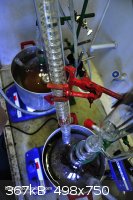
I have a blog where I post my pictures from my work: http://labphoto.tumblr.com/
-Pictures from chemistry, check it out(:
"You can’t become a chemist and expect to live forever." |
|
|
sargent1015
Hazard to Others
  
Posts: 315
Registered: 30-4-2012
Location: WI
Member Is Offline
Mood: Relaxed
|
|
Quote: Originally posted by kristofvagyok  | My new fav picture, soon I will make a hi-res print from this to my wall...(:
Two parallel reactions in two 4 liter flask equipped with reflux condensers, dropping funnels, placed on IKA magnetic stirrer/hotplates. Hope that
they will work…
Chemistry is awesome(:
|
That is a fantastic picture and looks great even with the dimensions on ScienceMadness 
|
|
|
White Yeti
National Hazard
   
Posts: 816
Registered: 20-7-2011
Location: Asperger's spectrum
Member Is Offline
Mood: delocalized
|
|
It's a nice picture, but may I ask why the condenser is hooked up to the side neck instead of the center one? I'm not saying it's wrong, but I've
never seen a condenser set up like that. Also, the addition funnel is usually connected to the side neck. Is there a particular reason for such a set
up?
"Ja, Kalzium, das ist alles!" -Otto Loewi
|
|
|
| Pages:
1
..
14
15
16
17
18
..
40 |